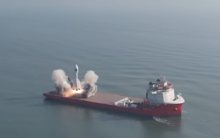Orienspace
 | |
 | |
Trade name | Orienspace |
|---|---|
Native name | 东方空间(山东)科技有限公司 |
| Company type | Private |
| Industry | Aerospace |
| Founded | June 9, 2020; 3 years ago (2020-06-09) |
| Headquarters | Yantai, Shandong , China |
| Website | www |
Orienspace Technology (Shandong) Co., Ltd (Orienspace for short) is a commercial aerospace enterprise in China founded in 2020. The company designs and manufactures Gravity Series launch vehicles and Force Series rocket engines.
Background
Orienspace is headquartered in Shandong Province, where an assembly, integration and test center is being built for future activities.[1]
The company also established an R&D center in Beijing Office and a headquarters of aerospace propulsion technology in Wuxi, Jiangsu Province.[2]
As of October 2023, Orienspace has raised four rounds of financing, totaling over 150 million USD.[3]
In January 2024, Orienspace Secures 600 Million Yuan Funding for Rocket Development Amid Soaring Demand in China[4]
Product lineup
Gravity-1 is a solid-propellant medium-lift launch vehicle that can carry a payload of up to 6.5 tons to LEO or 4.2 tons to SSO, enabling the deployment of large-scale satellite constellations. Its maiden flight was conducted on 11 January 2024, breaking records as both the world's largest solid-fuel carrier rocket and China's most powerful commercial launch vehicle to date.[5]
Gravity-2, a partially recoverable heavy-lift launch vehicle, is expected to debut in 2025. It will be a 60-meter-tall heavy-lift rocket with a liquid-fuel core stage and solid boosters. The core stage will be powered by nine Yuanli-85 engines, which are gas-generator cycle kerosene engines with a thrust of 100 tons each. The Gravity-2 will be able to deliver 25.6 tons of payload to LEO, 19.1 tons to a 500-kilometer sun-synchronous orbit (SSO), or 7.7 tons to geostationary transfer orbit (GTO).[5] It will also be partially recoverable and support missions to higher orbits such as MEO and LTO.
Gravity-3 is a planned variant of the Gravity-2 that will use three Gravity-2 core stages. It will have a payload capacity of 30.6 tons to LEO, 20.5 tons to SSO, 9.6 tons to GTO, and 8 tons to LTO.[5] It will enable large-scale satellite constellation deployment and lunar exploration.
List of launches
| Serial number | Launch Vehicle | Flight number | Date (UTC) | Launch site | Payload | Orbit | Outcome |
|---|---|---|---|---|---|---|---|
| 1 | Gravity-1 | Y1 | 11 January 2024 05:30 UTC | Special converted barge (Dong Fang Hang Tian Gang) Offshore waters of Haiyang Port | Yunyao-1 18-20 weather satellites | LEO (50° inclination, 500km circular) | Success[5] |
See also
References
- ^ "Chinese Rocket Newbie Orien Space Bags USD47.3 Million in Pre-A Round". www.yicaiglobal.com. Retrieved 17 October 2023.
- ^ "China's OrienSpace could be valued at $823 million in new fundraising -sources". Reuters. 22 August 2023. Retrieved 17 October 2023.
- ^ Jones, Andrew (13 February 2022). "A new Chinese rocket company has raised more than $100 million". Space.com. Retrieved 17 October 2023.
- ^ "Orienspace Secures 600 Million Yuan Funding for Rocket Development Amid Soaring Demand in China". ibmot. ibmot. 25 January 2024. Retrieved 25 January 2024.
- ^ a b c d Jones, Andrew (11 January 2024). "Orienspace breaks Chinese commercial launch records with Gravity-1 solid rocket". SpaceNews. Retrieved 11 January 2024.
External links
- Official website

- v
- t
- e
| Space cities |
|
|---|---|
| Monitoring and control centers |
| Suborbital launch sites | |
|---|---|
| Orbital launch sites |
landing site
organizations
| Universities and institutes |
|
|---|---|
| Ministries and agencies |
|
| Launch providers |
|
|---|---|
| Spacecraft manufacturers | |
| Component suppliers |
|










